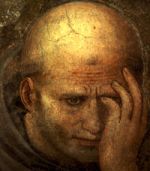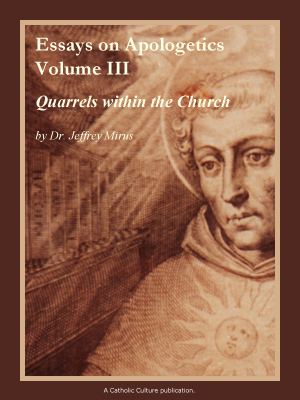At Historic 1990 Meeting, the Pope Was Able To Embrace His Ukrainian Brothers
They are the "invincibles". They are the Pastors whom the ferocious communist persecution could not weaken. Their faces are marked by suffering. They are faces that express and communicate hope. They are the faces of Pastors who endured the test. This is the "photograph" of the historic meeting desired by Pope John Paul II -- on 25 and 26 June 1990 in the Vatican's Old Synod Hall at the Vatican -- with the Catholic Bishops of the Ukrainian rite.
Eleven years after the historic meeting, on those same days in June, the Holy Father will make a pilgrimage to Ukraine. History marches on.
Today that June in 1990 seems a long time ago. The Berlin Wall had just fallen. The Church was taking her first breaths of freedom after the long night of persecution and martyrdom. The 10 Pastors who had just emerged from their clandestine existence, as well as the 19 Pastors of the diaspora who had long been living in the West, attended that meeting arranged by the Pope at the Vatican.
John Paul II first wanted a private conversation with each of the 10 Bishops who had survived the persecution, prior to meeting them all together. The Pope had never met them before. All he had heard about them had come from indirect sources. They told him of the harsh imprisonment they had endured in Siberia, even for just celebrating a marriage. They mentioned that they had seen a great number of their brothers die beside them and had also shared abuse and suffering with Orthodox priests. The "ecumenism of martyrs" is the most eloquent.
Among those 10 heroic Pastors was Volodymyr Sterniuk, the determined Redemptorist of Lviv, an austere figure with blue eyes hidden behind two round lenses. The concentration camps, the years spent chopping wood under constraint, harassments of every kind, had been unable to get the better of him. Arrested in 1947 for hearing the confessions of the faithful, he was first held in Lviv and then in Arkhangelsk, Siberia. He was forbidden to celebrate Mass, but, like his other companions in misfortune, he set aside a handful of breadcrumbs and a few grapes, which he left to ferment, so that he could celebrate Mass in secret. It is extraordinary how the Eucharist was the sign of unity and hope for everyone in the 20th century who suffered persecution anywhere. The testimonies of these contemporary martyrs are splendidly described in the stories of Masses celebrated in cells, in concentration camps, in places where God seemed absent.
Sterniuk never let his persecutors frighten him: in prison he administered Confession and Communion to many, fully aware of the risk he was taking, if he were discovered.
The Pastors Ivan Semedi of Uzhorod and Pavlo Vasylyk of Ivano-Frankivsk were also at the meeting with the Pope; three years before they had courageously come out in the open, appealing to the Supreme Soviet to obtain their release. There were elderly Bishops such as 77-year-old Philemon Kurchaba of Lviv and 73-year-old Sofron Dmyterko of Ivano-Frankivsk, who had been in prison from 1944 to 1954 and again from 1973 to 1975. There was also the very young Irynej Bilyk of Ivano-Frankivsk, who was just 43. To survive, one had worked as a doctor, another as a gardener. Collectively, the 10 Bishops had spent 40 years in prison, a small number in comparison to the thousands of years of prison suffered by their priests and faithful. Mykhajlo Sabricha (Lviv), Julian Woronowskyj (Lviv), Ivan Marghityc (Uzhorod) and Josyf Holowacz (Uzhorod) also took part.
The Ukrainian Bishops of the diaspora came from Canada, the United States of America, Brazil, Argentina, Australia, Great Britain, France, Germany, Poland and Yugoslavia. A "mosaic" depicting the tragedy of a suffering people. John Paul II was deeply moved when, after the individual meetings, he entered the Old Synod Hall with the 10 Bishops for their joint meeting. This meeting was marked by the address of then-Archbishop Angelo Sodano, Secretary for Relations with States, who summed up in a long and detailed speech the Holy See's constant and continuous efforts for the Ukrainian Church. The report on the "Catholic Church of the Ukrainian Rite, Past and Present" given by Archbishop Myroslav Stefan Marusyn, Secretary of the Congregation for the Oriental Churches, was very important.
In his address to the Holy Father, Cardinal Myroslav Ivan Lubachivsky, Major Archbishop of Lviv for Ukrainians (who died in December 2000), said that the hierarchy of all Rus' at last had the boundless joy of embracing the common Father of the Church, who presides in love. For the Ukrainian Prelates, this was a long-awaited moment, which they observed with deep fidelity and ecclesial unity and had prepared for with prayer.
John Paul II's address was very moving. "Behold", he said in Ukrainian, "for the first time in almost half a century, all the Bishops of the Catholic Church of the Byzantine-Slav rite, which has been carrying out her mission in the midst of God's People for almost 400 years within ancient Rus', or to use current usage, in Ukraine, Galicia (the land of Halych) and the Transcarpathian region, are meeting here together with the Bishops of the diaspora who work among emigrants in America, Australia and in the territory of Western Europe". This was the historic framework of this historic meeting.
The Millennium of the Baptism of Rus' marked the beginning of a new situation for this Church in her land of origin, the Holy Father said. Important changes have led to the recognition of the right to religious freedom for Eastern-rite Catholics and their Church in union with Rome. A Church, which had been absolutely outlawed in 1946, suppressed with a single blow, is coming out of the catacombs with her head held high.
This period of unspeakable suffering for the Bishops and the faithful lasted half a century. The memory of all who bore witness to their faith in Christ and his Church by paying with bloodshed or a higher price must not be forgotten. "We believe that their sacrifice and their prayers obtained for us the grace of this moment, of this new beginning", John Paul II said.
The Pope then pointed to reconciliation as one of the Church's first tasks in this new situation. Referring to the teaching of the Second Vatican Council, the Holy Father recalled that an intense ecumenical activity was one of the fruits of that assembly: "In the East the real dividing line passes, so to speak, right through the very centre of your history. At the time of the Baptism of Kievan Rus', in the year 988, the Church was still united. The break came a century later. But we must stress here that down the centuries, the Church of Kiev has constantly sought the possibility of rapprochement and reconciliation: the Union of Brest in the year 1586 was started with that intention".
John Paul II also said that the Eastern Churches in union with the See of Peter are a bridge of unity and therefore "in no way an obstacle!". A bridge linking the traditions and cultures of Western and Eastern Europe: "The continent", he said, "first divided in an artificial fashion following the Second World War, is beginning to regain its organic unity and solidarity. We know that what is involved here is the unity of two distinct traditions within culture and within the Church herself. These traditions -- the Eastern one for which the Apostles of the Slavs are the spokesmen, and the Western one whose patron is St Benedict -- must draw closer again". Concluding his address, the Pope entrusted all the participants to the Mother of God: "I have gone on pilgrimage many times in spirit to her shrines in your lands".
In his address, the then-Secretary for Relations with States, Archbishop Angelo Sodano, presented an overview of the Holy See's efforts for the Ukrainian-rite Catholic Church. "As soon as the storm of persecution was unleashed against the Catholic Church of the Ukrainian-rite, the Holy See began constant, systematic activity on that community's behalf, showing solidarity with their suffering, affirming their right to exist and vigorously calling for that right to be respected". Archbishop Sodano mentioned in particular the direct interventions of Pius XII in official documents such as the Encyclical Orientales Omnes Ecclesias of 23 December 1945; the Encyclical Orientales Ecclesias of 15 December 1952 and the Apostolic Letter Novimus vos of 20 January 1956. After the release of Cardinal Josyf Slipyj in February 1963, obtained through the intervention of Pope John XXIII, "the Holy See's activity on behalf of the Catholic Church of the Ukrainian-rite", Archbishop Sodano said, "was conducted principally in three directions: direct interventions and initiatives of a public nature by the Sovereign Pontiffs; statements and conversations within the context of international organizations; and personal contacts".
After presenting these courses of action, Archbishop Sodano ended his speech saying: "Those here present can be sure of one thing: the Holy See will continue to be always faithful to that Ukrainian community which was always faithful to her down the centuries'".
This item 3607 digitally provided courtesy of CatholicCulture.org






